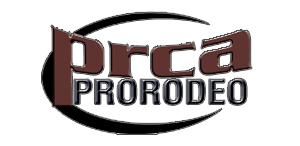Event Descriptions
Bareback Riding
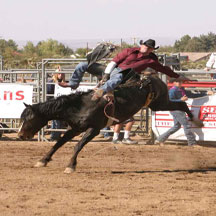
Bareback riders endure more abuse, suffer more injuries and carry away more long-term damage than all other rodeo cowboys.
To stay aboard the horse, a bareback rider uses a rigging made of leather and constructed to meet PRCA safety specifications. The rigging, which resembles a suitcase handle on a strap, is placed atop the horse's withers and secured with a cinch.
Bareback riding has been compared to riding a jackhammer with one hand. Jason Jeter can probably attest to that definition. As the bronc and rider burst from the chute, the rider must have both spurs touching the horse's shoulders until the horse's feet hit the ground after the initial move from the chute. This is called "marking out." If the cowboy fails to do this, he is disqualified.
As the bronc bucks, the rider pulls his knees up, rolling his spurs up the horse's shoulders. As the horse descends, the cowboy straightens his legs, returning his spurs over the point of the horse's shoulders in anticipation of the next jump.
Making a qualified ride and earning a money-winning score requires more than just strength. A bareback rider is judged on his spurring technique, the degree to which his toes remain turned out while he is spurring and his willingness to take whatever might come during his ride.
It's a tough way to make a living, all right. But, according to bareback riders, it's the cowboy way.
Steer Wrestling
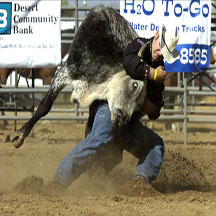
Speed and strength are the name of the game in steer wrestling. In fact, with a world record sitting at 2.4 seconds, steer wrestling is the quickest event in rodeo.
The objective of the steer wrestler, who is also known as a "bulldogger," is to use strength and technique to wrestle a steer to the ground as quickly as possible.
That sounds simple enough.
Here's the catch: the steer generally weighs more than twice as much as the cowboy and, at the time the two come together, they're both often traveling at 30 miles per hour. Speed and precision, the two most important ingredients in steer wrestling, make bulldogging one of rodeo's most challenging events.
As with tie-down and team ropers, the bulldogger starts on horseback in a box. A breakaway rope barrier is attached to the steer and stretched across the open end of the box. The steer gets a head start that is determined by the size of the arena. When the steer reaches the advantage point, the barrier is released and the bulldogger takes off in pursuit. If the bulldogger breaks the barrier before the steer reaches his head start, a 10-second penalty is assessed.
A perfect combination of strength, timing and technique are necessary for success in the lightning-quick event of steer wrestling. In addition to strength, two other skills critical to success in steer wrestling are timing and balance.
When the cowboy reaches the steer, he slides down and off the right side of his galloping horse, hooks his right arm around the steer's right horn, grasps the left horn with his left hand and, using strength and leverage, slows the animal and wrestles it to the ground. His work isn't complete until the steer is on its side with all four feet pointing the same direction. That's still not all there is to it.
To catch the sprinting steer, the cowboy uses a "hazer," who is another mounted cowboy who gallops his horse along the right side of the steer and keeps it from veering away from the bulldogger.
The efforts of the hazer can be nearly as important as those of the steer wrestler. For that reason, and the fact that he sometimes supplies the bulldogger with a horse, the hazer often receives a fourth of the payoff.
Team Roping
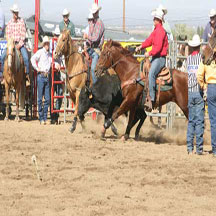
Team roping, the only true team event in ProRodeo, requires close cooperation and timing between two highly skilled ropers - a header and a heeler - and their horses. The event originated on ranches when cowboys needed to treat or brand large steers and the task proved too difficult for one man.
The key to success?Hard work and endless practice. Team roping partners must perfect their timing, both as a team and with their respective horses.
Similar to tie-down ropers and steer wrestlers, team ropers start from the boxes on each side of the chute from which the steer enters the arena. The steer gets a head start determined by the length of the arena.
Team ropers such as Joe Beaver and Travis Tryan spend long hours perfecting their timing with each other and their horses. One end of a breakaway barrier is attached to the steer and stretched across the open end of the header's box. When the steer reaches his advantage point, the barrier is released, and the header takes off in pursuit, with the heeler trailing slightly further behind. The ropers are assessed a 10-second penalty if the header breaks the barrier before the steer completes his head start. Some rodeos use heeler barriers too.
The header ropes first and must make one of three legal catches on the steer — around both horns, around one horn and the head or around the neck. Any other catch by the header is considered illegal and the team is disqualified. After the header makes his catch, he turns the steer to the left and exposes the steer's hind legs to the heeler. The heeler then attempts to rope both hind legs. If he catches only one foot, the team is assessed a five-second penalty. After the cowboys catch the steer, the clock is stopped when there is no slack in their ropes and their horses face one another.
Another important aspect to the event is the type of horses used by the ropers. The American quarter horse is the most popular among all timed-event competitors, particularly team ropers. Heading horses generally are taller and heavier because they need the power to turn the steer after it is roped. Heeling horses are quick and agile, enabling them to better follow the steer and react to it moves.
Saddle Bronc Riding
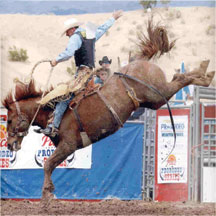
Saddle bronc riding is rodeo's classic event, both a complement and contrast to the wilder spectacles of bareback riding and bull riding. This event requires strength to be sure, but the event also demands style, grace and precise timing.
Saddle bronc riding evolved from the task of breaking and training horses to work the cattle ranches of the Old West. Many cowboys claim riding saddle broncs is the toughest rodeo event to master because of the technical skills necessary for success.
Every move the bronc rider makes must be synchronized with the movement of the horse. The cowboy's objective is a fluid ride, somewhat in contrast to the wilder and less-controlled rides of bareback riders.
Dan Erickson shows the form and technique that have made him a Wranger NFR qualifying saddle bronc rider. One of the similarities shared by saddle bronc and bareback riding is the rule that riders in both events must mark out their horses on the first jump from the chute. To properly mark out his horse, the saddle bronc rider must have both heels touching the animal above the point of its shoulders when it makes its first jump from the chute. If the rider misses his mark, he receives no score.
While a bareback rider has a rigging to hold onto, the saddle bronc rider has only a thick rein attached to his horse's halter. Using one hand, the cowboy tries to stay securely seated in his saddle. If he touches any part of the horse or his own body with his free hand, he is disqualified.
Judges score the horse's bucking action, the cowboy's control of the horse and the cowboy's spurring action. While striving to keep his toes turned outward, the rider spurs from the points of the horse's shoulders to the back of the saddle. To score well, the rider must maintain that action throughout the eight-second ride. While the bucking ability of the horse is quite naturally built into the scoring system, a smooth, rhythmic ride is sure to score better than a wild, uncontrolled effort.
Tie-Down Roping
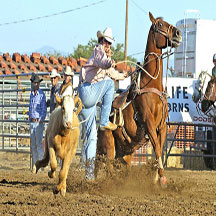
As with saddle bronc riding and team roping, the roots of tie-down roping can be traced back to the working ranches of the Old West. When calves were sick or injured, cowboys had to rope and immobilize them quickly for veterinary treatment. Ranch hands prided themselves on the speed with which they could rope and tie calves, and they soon turned their work into informal contests.
As the event matured, being a good horseman and a fast sprinter became as important to the competitive tie-down roper as being quick and accurate with a rope.
Today, the mounted cowboy starts from a box, a three-sided fenced area adjacent to the chute holding the calf. The fourth side of the box opens into the arena.
A cowboy's success in tie-down roping depends in large part on the precise teamwork between him and his horse. The calf receives a head start that is determined by the length of the arena. One end of a breakaway rope barrier is looped around the calf's neck and stretched across the open end of the box. When the calf reaches its advantage point, the barrier is released. If the roper breaks the barrier before the calf reaches its head start, the cowboy is assessed a 10-second penalty.
The horse is trained to come to a stop as soon as the cowboy throws his loop and catches the calf. The cowboy then dismounts, sprints to the calf and throws it by hand, a maneuver called flanking. If the calf is not standing when the cowboy reaches it, he must allow the calf to get back on its feet before flanking it. After the calf is flanked, the roper ties any three legs together with a pigging string - a short, looped rope he clenches in his teeth during the run.
While the contestant is accomplishing all of that, his horse must pull back hard enough to eliminate any slack in the rope, but not so hard as to drag the calf.
When the roper finishes tying the calf, he throws his hands in the air as a signal that the run is completed. The roper then remounts his horse, rides forward to create slack in the rope and waits six seconds to see if the calf remains tied. If the calf kicks free, the roper receives no time.
Bull Riding
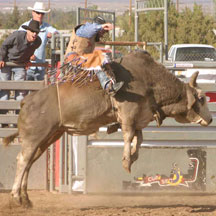
Rodeo competition, in the beginning, was a natural extension of the daily challenges cowboys confronted on the ranch - roping calves and breaking broncs into saddle horses.
Bull riding, which is intentionally climbing on the back of a 2,000-pound bull, emerged from the fearless and possibly fool-hardy nature of the cowboy. The risks are obvious. Serious injury is always a possibility for those fearless enough to sit astride an animal that literally weighs a ton and is usually equipped with dangerous horns.
Regardless, cowboys do it, fans love it and bull riding ranks as one of rodeo's most popular events.
Bull riding is dangerous and predictably exciting, demanding intense physical prowess, supreme mental toughness and courage. Like bareback and saddle bronc riders, the bull rider may use only one hand to stay aboard during the eight-second ride. If he touches the bull or himself with his free hand, he receives no score. But unlike the other roughstock contestants, bull riders are not required to mark out their animals. While spurring a bull can add to the cowboy's score, riders are commonly judged solely on their ability to stay aboard the twisting, bucking mass of muscle.
Size, agility and power create a danger that makes bull riding a crowd favorite everywhere. Balance, flexibility, coordination, quick reflexes and, perhaps above all, a strong mental attitude are the stuff of which good bull riders are made.
To stay aboard the bull, a rider grasps a flat braided rope, which is wrapped around the bull's chest just behind the front legs and over its withers. One end of the bull rope, called the tail, is threaded through a loop on the other end and tightened around the bull. The rider then wraps the tail around his hand, sometimes weaving it through his fingers to further secure his grip.
Then he nods his head, the chute gate swings open, and he and the bull explode into the arena.
Every bull is unique in its bucking habits. A bull may dart to the left, then to the right, then rear back. Some spin or continuously circle in one spot in the arena. Others add jumps or kicks to their spins, while others might jump and kick in a straight line or move side to side while bucking.
All-Around
The PRCA world all-around champion is considered by many the most talented and versatile cowboy in the sport. The PRCA Cowboy who wins the most prize money in a year while competing in at least two events, earning a minimum of $3,000 in each event, wins the world all-around championship.
